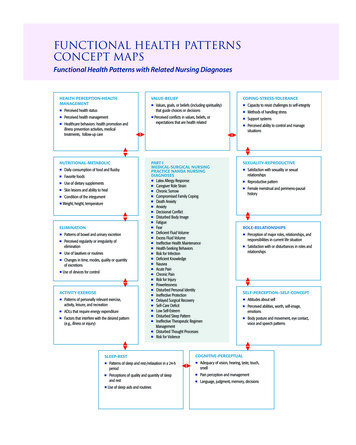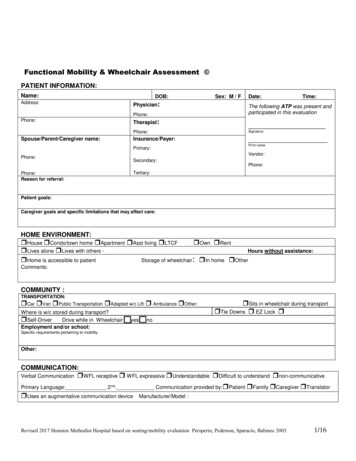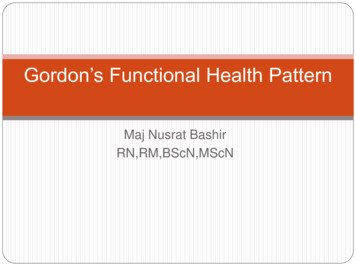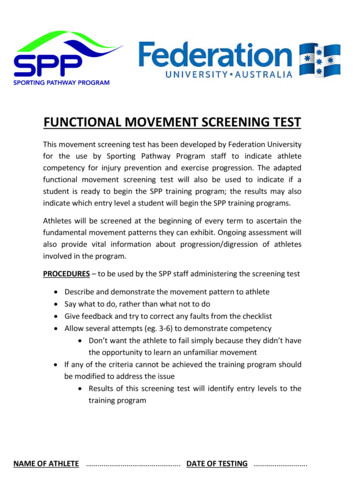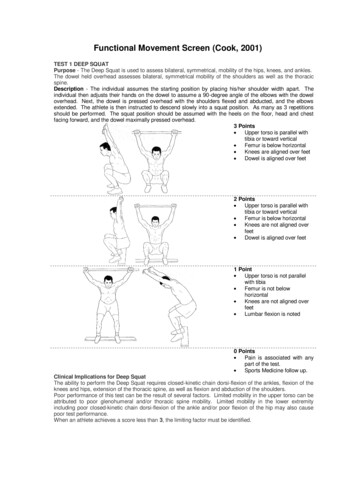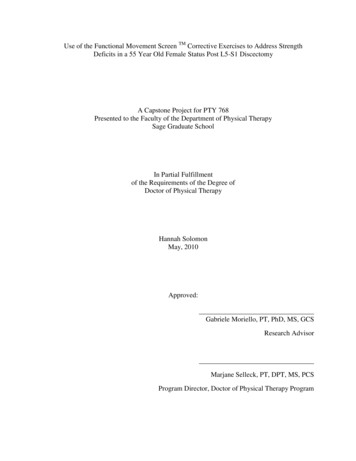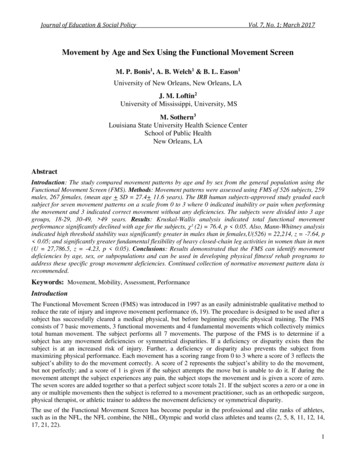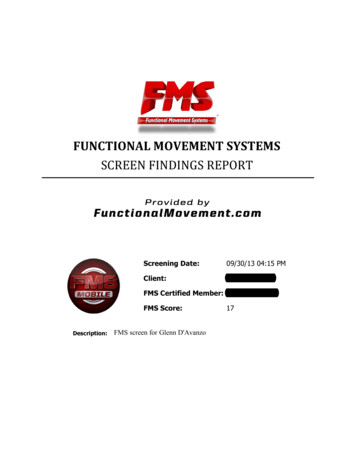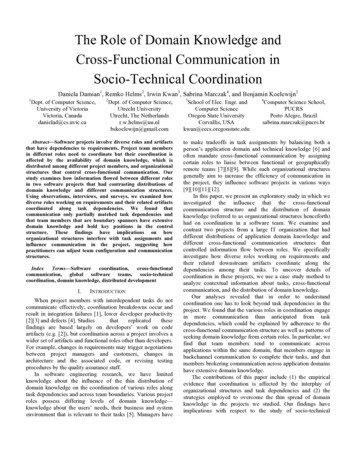
Transcription
AN INTRODUCTIONTO THE FUNCTIONALMOVEMENT SCREEN
The Functional Movement ScreenThe Functional Movement Screen (FMS) is a screening tool used to evaluate sevenfundamental movement patterns in individuals with no current pain complaint ormusculoskeletal injury. The FMS is not intended to diagnose orthopedic problems but ratherto demonstrate opportunities for improved movement in individuals.The screen is designed to place an individual in extreme positions where movementdeficits become noticeable if appropriate stability and mobility are not used. Even thoughindividuals are performing an activity or sport at a high level, it has been observed thatmany of these same individuals are limited in fundamental movement. This leads to theuse of compensatory movements in order to achieve or maintain the level of performanceneeded for the activity. The inefficient use of compensation during movement will lead topoor biomechanics that limit gains in performance and reduces the body’s ability to remainadaptable and durable against the risks of being involved in the activity or sport.The 7 Movement Patterns1. DEEP SQUATThe Deep Squat pattern challenges total body mechanics and neuromuscular control. We useit to test bilateral, symmetrical, functional mobility and stability of the hips, knees and ankles.The dowel overhead requires bilateral symmetrical mobility and stability of the shoulders,scapular region and the thoracic spine. The pelvis and core must establish stability and controlthroughout the entire movement to achieve the full pattern.
2. HURDLE STEPThe hurdle step pattern is an integral part of locomotion and acceleration. This movementchallenges the body’s step and stride mechanics, while testing stability and control in a singleleg stance. The hurdle step requires bilateral mobility and stability of the hips, knees andankles. The test also challenges stability and control of the pelvis and core as it offers anopportunity to observe functional symmetry.3. INLINE LUNGEThe Inline Lunge pattern places the body in a position to simulate stresses during rotation,deceleration and lateral movements. The inline lunge places the lower extremities in a splitstance while the upper extremities are in an opposite or reciprocal pattern. This replicates thenatural counterbalance the upper and lower extremities use to complement each other, as ituniquely demands spine stabilization. This test also challenges hip, knee, ankle and foot mobilityand stability.
4. SHOULDER MOBILITYThe Shoulder Mobility pattern demonstrates the natural complementary rhythm of thescapular-thoracic region, thoracic spine and rib cage during reciprocal upper-extremity shouldermovements. This pattern also observes bilateral shoulder range of motion, combining extension,internal rotation and adduction in one extremity, and flexion, external rotation and abduction ofthe other.5. ACTIVE STRAIGHT-LEG RAISEThe Active Straight-Leg Raise pattern not only identifies the active mobility of the flexed hip,but looks at the core stability within the pattern, as well as the available hip extension of thealternate hip. This is not so much a test of hip flexion on one side, as it is an appraisal of theability to separate the lower extremities in an unloaded position. This pattern also challenges theability to dissociate the lower extremities while maintaining stability in the pelvis and core.
6. TRUNK STABILITY PUSH UPThe Trunk Stability Push-Up pattern is used as a basic observation of reflex core stabilization,and is not a test or measure of upper body strength. The goal is to initiate movement with theupper extremities in a push up pattern without allowing movement in the spine or hips. Themovement tests the ability to stabilize the spine in the sagittal plane during the closed kineticchain, upper body symmetrical movement.7. ROTARY STABILITYThe Rotary Stability pattern is complex, requiring proper neuromuscular coordination andenergy transfer through the torso. This pattern observes multi-plane pelvis, core and shouldergirdle stability during a combined upper and lower extremity movement. The movementdemonstrates reflex stabilization and weight shifting in the transverse plane, and it representsthe coordinated efforts of mobility and stability observed in fundamental climbing patterns.
Scoring CriteriaThe FMS uses a simplistic grading system. Each individual movement pattern has certaincriteria that must be accomplished in order to obtain a high score. The scoring is brokendown into four basic criteria:3Three is given if the individual can perform themovement without any compensations accordingto the established criteria2Two is given if the individual can perform themovement but must utilize poor mechanics andcompensatory patterns to accomplish the movement1One is given if the individual cannot perform themovement pattern even with compensations0Zero is given if the individual has pain duringany part of the movementThere are five movement patterns which require bilateral testing; this will result in twoscores for those patterns. The lowest score is recorded for the final score; however, forassessment and data collection purposes, both scores are needed. Three tests: ShoulderMobility, Trunk Stability Push-Up and Rotary Stability have clearing test associated withthem that are scored as pass/fail. If a person fails this part of the test, then a 0 is givenas the overall score.
Interpreting Screen Results and InterventionWithin the FMS there is an algorithm or procedure for addressing the asymmetries andrestrictions found in the screen. The algorithm allows us to quickly identify and prioritizedeficient movement patterns. Once the priority movement pattern has been identified, thisallows for targeted intervention using corrective exercise. If an individual has no areas ofconcern within a movement pattern then they would be cleared to train and load that pattern.This provides an appropriate movement baseline for further physical capacity and performancetesting, such as the Y-Balance Test.If an individual has pain during the screen, the individual should be referred out to a healthcareprofessional for a Selective Functional Movement Assessment (SFMA). The SFMA is a total bodydiagnostic system designed to provide an efficient method for systematically finding the causeof the patient’s pain, not just the source.When to use the FMSIdeally the FMS would be introduced as a part of a pre-placement or pre-participationexamination to determine deficits that may be overlooked during the traditional medical andperformance evaluations. Muscle flexibility, strength imbalances or compensation due toprevious injury are all acknowledged as significant risk factors for injury. In many cases, theFMS will pinpoint these issues that may not be identified in other standard evaluations. Thefunctional movement screen will identify functional deficits related to proprioceptive, mobilityand stability limitations. If these risk factors can be identified and addressed using the FMS,then decreases in injuries and improved performance should follow.The FMS can also be used to re-screen for feedback every 4-6 weeks or when an improvementis seen in the priority movement pattern. Re-screening provides feedback into the effectivenessof the current program design and provides insight on how and when to move to higher levelprogressions or a new priority movement pattern.
TO LEARN MORE ABOUTFMS VISIT US ATwww.FunctionalMovement.com
functional movement screen will identify functional deficits related to proprioceptive, mobility and stability limitations. If these risk factors can be identified and addressed using the FMS, then decreases in injuries and improved performance should follow. The FMS can also be used to re-screen for feedback every 4-6 weeks or when an improvement is seen in the priority movement pattern. Re .File Size: 743KBPage Count: 8Explore furtherFunctional Movement Screen (FMS) - Physiopediawww.physio-pedia.comThe Functional Movement Screen - ADVANCED FITNESS CON www.advanced-fitness-concepts Functional Movement Assessmentwww.rehabeducation.comFunctional Movement Screen- 7 Screens and 3 Clearing Tests .www.improvementwarriorfitness. The Functional Movement Screen (FMS) Reviewedwww.painscience.comRecommended to you based on what's popular Feedback


